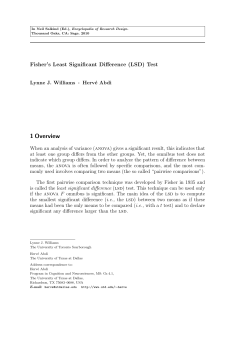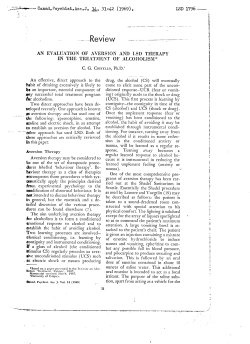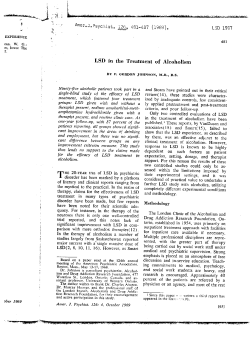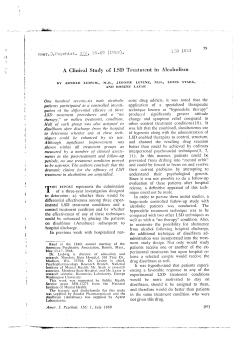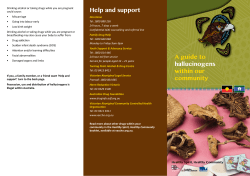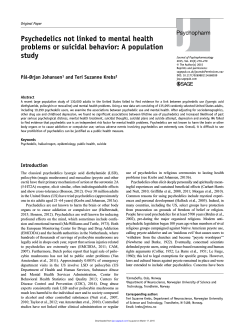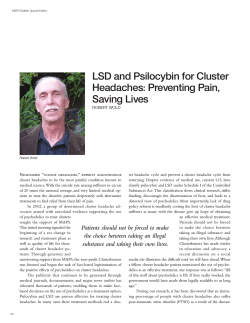
LSD Do You Know... What is it?
Street names: acid, blotter, microdot, window pane What is it? LSD (lysergic acid diethylamide) is a potent hallucinogen—that is, a drug that can alter a person’s perception of reality and vividly distort the senses. LSD was originally derived from “ergot,” a fungus that grows on rye and other grains. The hallucinogenic effect of LSD was first discovered in 1943 by Dr. Albert Hofmann, a Swiss research chemist working at a pharmaceutical company. Early studies exploring potential use of the drug focused on what insight it might offer into certain kinds of mental illness. In the 1950s, intellectuals such as Aldous Huxley experimented with the drug for its alleged ability to induce a state of “cosmic consciousness.” LSD was the subject of numerous research studies in the 1950s and early 1960s. These studies included investigating the therapeutic potential of the “psychedelic” experience in 1/4 © 2001, 2010 CAMH | www.camh.ca LSD Do You Know... treating chronic alcoholism and mental illness, and in helping patients with terminal illnesses to accept death. LSD also captured the attention of the CIA, who tested its potential for use in psychological warfare. How is LSD used? Recreational use of LSD increased in the 1960s as its “mind-expanding” qualities were promoted by influential role models such as Harvard scientist Timothy Leary and novelist Ken Kesey. How does LSD make you feel? Concerns about the possible long-term effects of LSD led to new laws aimed at restricting its use. The sale, possession for the purpose of selling, and distribution of LSD were first made punishable in Canada in 1962. LSD currently has no medical use, and is prohibited under Schedule III of Canada’s Controlled Drugs and Substances Act. Where does LSD come from? Most LSD is produced in illegal laboratories, with only a very small amount legally manufactured for use in research. What does LSD look like? Pure LSD is a white, crystalline powder that dissolves in water. It is odourless and has a slightly bitter taste. An effective dose of the pure drug is too small to see (20 to 80 micrograms). LSD is usually packaged in squares of LSD-soaked paper (“blotters”), miniature powder pellets (“microdots”) or gelatin chips (“window pane”). Blotters are sometimes printed with illustrations of cartoon characters. Who uses LSD? People who use LSD range from those seeking a high to those seeking a mystical experience. The incidence of LSD use reached its peak during the 1960s and 1970s, and was closely associated with the “hippie” youth culture of that time. Rates of LSD use dropped in the 1980s, rose again in the 1990s, and have since dropped back down to low levels. The use of LSD among Ontario students in grades 7 to 12 dropped from 6.8 per cent in 1999 to 1.8 per cent in 2009. 2/4 | © 2001, 2010 CAMH | www.camh.ca LSD is usually taken by mouth and held on the tongue or swallowed, but there have been reports of it being inhaled or injected. How LSD affects you depends on several things: ·· your age ·· how sensitive you are to the drug ·· how much you take and how often you take it ·· how long you’ve been taking it ·· the method you use to take the drug ·· the environment you’re in ·· whether or not you have certain pre-existing medical or psychiatric conditions ·· whether you’ve taken any alcohol or other drugs (illegal, prescription, over-the-counter or herbal). The physical effects of LSD may include numbness, rapid heartbeat, reduced co-ordination, chills, nausea, tremor, weakness and dilated pupils. Sensations of gravity may be altered, ranging from feeling weighted down, to feeling light and floating. The LSD experience, usually referred to as a “trip,” varies widely and is unpredictable. Individual reactions to the drug can range from ecstasy to terror, even within a single drug-taking experience. People who have used the drug before, and had a positive experience, may have a negative experience if they take it again. Two factors that influence the way people feel when they take LSD are their “mindset”—their expectations, experience and mood at the time they take the drug— and the setting, or place where they are. For those who use the drug, the possibility of an adverse reaction, or “bad trip,” may be reduced by taking the drug only when already in a positive state of mind, in a relaxed environment and with supportive friends. LSD produces vivid visual effects. Colours seem to become more intense, halos or rainbows may appear around objects, and shapes may become fluid in form. Rapidly changing, brightly coloured geometric patterns and other images may be seen, whether the eyes are open or shut. These visual distortions are referred to as “pseudo-hallucinations” because people know that what they are seeing is not real and is due to the effect of the drug. True hallucinations, where people believe that what they are seeing is real, are not as common, but they can occur and can be frightening. LSD affects your senses, mood, thoughts and how you perceive yourself and the world around you. The drug can produce a wide spectrum of mental states, from a sense of joy, wonder and heightened sensitivity, to panic, confusion and anxiety. Thoughts may seem clear and profound or race rapidly without logic. Sense of time, distance and body image may be distorted. Boundaries between the self and the outside world may seem to dissolve. Some users report a fusion of the senses; for example, “seeing” music or “hearing” colour. How long does the feeling last? The effects of LSD come on gradually within an hour of taking the drug, peak at two to four hours and gradually taper off, with the entire trip lasting up to 12 hours. The intensity of the effect depends on the size of the dose. Some users feel let down or fatigued for 12 to 24 hours after the trip is over. Is LSD dangerous? It can be. Sometimes people who take the drug feel that the experience gets out of control. They may feel they are osing their identity or are disintegrating into nothingness. Such a reaction can lead to a state of panic. They may try to flee the situation, or become paranoid and frightful and lash out at the people around them. People experiencing a dangerous reaction to LSD should be kept as calm as possible. If their distress continues, they should receive treatment at a hospital emergency room. No deaths resulting exclusively from an overdose of LSD have been reported. However, LSD affects judgment, which can lead to irrational, sometimes dangerous, 3/4 | © 2001, 2010 CAMH | www.camh.ca behaviour. The drug has made people feel that they could fly, or that they could walk through traffic, and this has resulted in accidental injuries and deaths. In some people, LSD may release underlying psychosis or aggravate anxiety or depression. Long-term psychological problems may follow a bad trip with LSD. Taking only a small amount, or low dose, of LSD may not reduce the possibility of having a negative reaction. One person may have a bad trip on a low dose, while another may take a high dose and get through it without distress. Higher doses do, however, increase the hallucinogenic effect of the drug. Because LSD is produced illegally, it varies in purity and strength. If you take LSD, you can’t be sure exactly what or how much you are taking, or how it will affect you. Because LSD profoundly alters perception, it is highly hazardous to drive a vehicle while under the drug’s influence. Is LSD addictive? Yes, it can be addictive. Some people who use LSD repeatedly feel compelled to take it. The drug takes on an exaggerated importance in their lives, leading to emotional and lifestyle problems. People who use LSD regularly do not experience physical withdrawal symptoms when they stop taking the drug. However, regular use of LSD will produce “tolerance” to the effects of the drug. This means that if LSD is taken repeatedly over a period of several days, it no longer has the same effect. After several days of not taking the drug, it becomes effective once again. What are the long-term effects of taking LSD? One in a series... The use of LSD can result in long-term effects for both one-time and regular users of the drug. Possible negative effects are “flashbacks” of the drug experience, as well as prolonged anxiety, depression or psychosis. These reactions usually decrease over time, and end within a few months after LSD was last taken, but may continue for years. Alcohol Alcohol, Other Drugs and Driving Amphetamines Anabolic Steroids Benzodiazepines Caffeine Cannabis Cocaine Ecstasy Flashbacks are the spontaneous and unpredictable replay of an aspect of the LSD trip, occurring some time after the initial effects of the drug have worn off. Visual or emotional experiences that were originally seen or felt while under the influence of LSD are re-experienced. Flashbacks usually last only a few seconds or minutes, but may happen over and over again. Only some people who take LSD have flashbacks, but frequent users of the drug are said to be at greater risk. Flashbacks may be triggered by smoking marijuana or drinking alcohol, or by emotional stress or fatigue. Depression or anxiety may follow a bad trip. Psychosis may develop after using LSD, although it is thought that this reaction may be more likely to occur in people with latent, or underlying, mental health problems. GHB Hallucinogens Heroin Inhalants Ketamine LSD Methadone Methamphetamine Prescription Opioids Tobacco For more information on addiction and mental health issues, or to download a copy of this brochure, please visit our website: www.camh.ca This publication may be available in other formats. For information about alternative formats, to order multiple copies of this brochure, or to order other CAMH publications, please contact Sales and Distribution: Toll-free: 1 800 661-1111 Toronto: 416 595-6059 E-mail: publications@camh.ca Online store: http://store.camh.ca To make a donation, please contact the CAMH Foundation: Tel.: 416 979-6909 E-mail: foundation@camh.ca If you have questions, concerns or compliments about services at CAMH, please contact the Client Relations Service: Tel.: 416 535-8501 ext. 32028 or 32027 Copyright © 2001, 2010 Centre for Addiction and Mental Health A Pan American Health Organization / World Health Organization Collaborating Centre Fully affiliated with the University of Toronto Disponible en français. 4/4 | © 2001, 2010 CAMH | www.camh.ca 4274l/02-2013 / P271
© Copyright 2025

